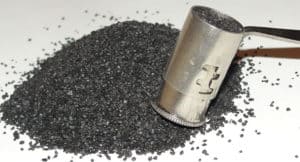Disclaimer
Some of the methods discussed in this article are dangerous or even deadly. You attempt them at your own risk.
I need to tell you that I’m completely biased when it comes to shotguns. There’s just something about them – the satisfying click of the action, the roar of a big magnum load sending an ounce or more of lead downrange that satisfies me in a primal way.
If I could only pick one gun to take with me into the wastelands of post-SHTF America, it’s going to be a good old 12 gauge pump every time.
When Your Ammo Runs Out
I’ve always been curious about one thing: staying power.
Even my shotgun, which should be easier than just about anything to keep topped up with hand-load ammo, isn’t any better than a Remington-brand club without lead and powder, and primers.
How the hell are you supposed to take care of a weapon when supplies are short and times are tough?
Basic Shotgun Maintenance

If you’re prepared – and I imagine that the people reading this are better prepared than most — you’ve got at least the bare minimum you need to keep your weapon operating.
You’ve stocked up on Hoppes No. 9, got a double-ought mold and a decent supply of lead, and maybe you’ve even laid into some primers and powder.
But supplies don’t last forever.
As I see it, you’ve got five main concerns if you’re going to keep yourself stocked with shotgun ammunition after things go bad:
- Shells
- Powder
- Primer
- Shot
- Solvent
We’re going to tackle them in order.
Keeping a modern weapon running without the benefits of society is hard work. You might find it easier to buy a bow instead.
Crafting Shotshells
High-brass magnum shells aren’t a luxury you can afford when everything around you is going to hell.
In my opinion, and this will be a recurring theme, you’ve got to look to the past for answers. Before the 1960’s paper hulls were common. They were made around a sizing dowel by wrapping around layers of paper and glue and then sealing it up with wax.
Even the cartridge head and wadding can be made of paper if you get creative, as YouTuber Tacome1942 did:
Now, there’s a reason why we don’t see paper shells much anymore. Even with a wax or varnish coating, paper shells are vulnerable to moisture.
They can swell up, stick in the chamber, or even squib out and fail to fire entirely if they get wet enough.
Recycling your old shells is probably the best choice, but if it ever comes right down to it, you can make an entire shotshell out of paper, glue, and wax.
I’d think twice about putting homebrew paper shells in a tube mag, but aside from that, they should shoot just fine.
The only issue you will run into is with extraction; by all accounts, paper shells get stuck in the chamber more often.
Homemade Black Powder

Smokeless powder represents hundreds of years of advances in chemistry and engineering. If everything around us is dusted, we will have to get primitive.
Black powder is easy to make with ingredients you can stockpile or make yourself.
The simplest recipes use two ingredients:
- Charcoal – 20%
- Potassium Nitrate – 80%
With this mix, the charcoal acts as a fuel while the potassium nitrate is the oxidizer.
Combine the two, and you have a crude explosive powerful enough to send lead downrange.
Making Charcoal
Charcoal is easy enough to make; all you need to find is some wood and burn it in a reduced oxygen environment.
For instance, you could punch a small hole in the lid of a paint can, load it up with sticks, and toss the whole thing on a low fire for an hour or two.
Making Potassium Nitrate
Potassium nitrate, or saltpeter, is slightly more complicated to make. Of course, you can stock up on it perfectly legally. But to make it at home, you’ll have to learn some chemistry.
If you’re really dedicated, you can make potassium nitrate by peeing in a bowl full of wood, ash, and dirt.
Yeah, you read that right!
Dirt is home to bacteria that splits the ammonia in urine into simpler nitrogen compounds.
Wood ash is full of potassium hydroxide, which combines with simple acidic nitrates to make potassium nitrate.
After a few weeks, you can extract the mix with boiling water and leave it to evaporate, yielding crude saltpeter. In the Middle Ages, this is precisely how they made gunpowder.
Assuming your wife won’t be thrilled about having a bowl full of urine and dirt around the house, a better method is to use cold packs and salt substitute.
The NurdRage YouTube channel put together a quick guide.
After you’ve mixed your powdered charcoal and saltpeter, wet it slightly and run everything through a kitchen sieve.
This will yield a uniform powder you can measure reliably and use to load up your paper shells.
Making Your Own Primers
If you thought gunpowder was tricky, it’s nothing compared to impact-sensitive primers.
These things took hundreds of years to develop, even after we figured out how to make black powder. The secret is coming up with a compound that will blow up when struck sharply but won’t go off all on its own.
The easiest is to use paper caps. You probably remember your cap gun when you were a kid; we’re talking about the same thing. It turns out that paper caps work pretty well as shotgun primers.
Casting Shot
At least, in my opinion, the real strength of a shotgun is that you don’t need a precision cast and rifled slug to make a kill.
Casting shot is pretty easy, even when things are broken down and you’re working out of a boarded-up garage. If you’ve got a buckshot mold, you can make beautiful pellets. But even if you don’t have one, you’re not out of luck.
See, molten lead can be dripped into water, and it will form pretty perfect spheres if you do it right.
You’ll need to experiment a little to perfect the sizing, but this is easy to do as long as you have a torch.
Here, YouTuber gun nut shows us some tips and tricks:
Cleaning and Lubrication
Black powder shooters will tell you that muzzleloaders need a ton of cleaning. Even with modern powders, the rate of fouling and the amount of deposits left in the barrel are way more significant when you’re not shooting smokeless.
To keep your weapon clean, you will need solvent and lubricating oil. I don’t even want to consider a world without Hoppes No. 9; I like the smell too much.
But if things are dire, you still have options.
To remove powder and lead fouling, any of the below will work just fine:
Gasoline
Kerosene
Soap and Water
Ammonia
WD-40 (or WD-40 substitute)
Lamp Oil
Copper fouling is a whole different story, though. It’s not one we’re focusing on with our hypothetical SHTF shotgun, but your best bet is probably to scrub like hell.
Lubrication is another essential maintenance task.
You’ll need some kind of grease or oil; just don’t mix and match. Here are a few options:
Red Grease
Lard
Vegetable Oil
Motor Oil
Molybdenum Disulfide
Lamp Oil
Just clean everything up with a solvent and immediately lubricate it to keep things from rusting up on you, and your shotgun will be fine.
Is It Worthwhile?
I’ll be the first to admit some of these suggestions aren’t super practical.
Making your own powder and primers will be hard work if you don’t have some sort of stockpile on hand. I still think it’s vital that you know how it can be done.
If anything, it should give you a bit of appreciation for how easy we’ve got things right now.
Let’s hope that doesn’t slip away from us because when you consider how much we rely on society, the alternative is a pretty scary thought.



Hey duders!
Thanks for this!
been looking for a good tutorial on post shtf gun care and black powder making tutorial!
Thank you for the informative write-up with videos to boot. I may try this method. I’ve been looking for spent 12 gauge and .410 gauge shotshells for reloading. Love the “molten lead/Water buck-shoot” idea. This will help a lot with my expermintal 12g/.410 slambang survival shotgun. I know “factory rounds” do work on it but I really want to do it all from scratch.
An interesting article. I think that if we ever do have a TEOTWAWKI event, or the more likely socioeconomic collapse, modern firearms and ammunition will be best reserved for self defense, due to the difficulty and danger of producing propellant and primers. It might be a good idea to add a flintlock or two, or even a matchlock, to the collection for putting meat on the table or dealing with the casual trespasser. A blunderbuss is just as impressive now as it was in 1750. Better yet, a basic flat bow. Guns are loud. It may not be a good idea to announce your presence to every living thing within ten miles. Keep in mind that toy paper caps, in the unlikely event that any can be found, are usually made of silver fulminate. This is much more sensitive to initiation than typical primer mixtures. If you use it, be aware that a dropped round (or a loaded firearm, maybe the whole magazine) could go off.
You can make (lower powered) explosive powder by grinding up any kind of match heads. It works quite well for shooting fishing weights out of a metal pipe.
If anyone wants me to post an instructable on it (the pipe gun) I can.
I’d like that please
Please do!!
Good info. Thanks
I know a few guys that use a zinc alloy for cleaning their barrels of copper and lead deposits…something to look into as I am not certain of the exact alloy. I would think using match-heads would result in a much more consistent and reliable primer, though perhaps using a single hole punch to trim the paper from those caps might work better than scissors.
Could work in a pinch I guess.
I was thinking of experimenting with plants. For example, milkweed sap. It was used by the First Nations…can’t remember why. But, if harvested how hard will the sap harden? I was wondering if it could harden down to form a bullet or molded into an arrow? It just has to be hard enough to hit skin, right? Other saps from trees are too pliable but maybe a combination of ingredients or a certain length of time could produce a hard material?
Hi Iris – I’m honestly not sure about this, if any readers have anything to add please leave your comment here.
The first known epoxy type resin was made from pine pitch and beeswax. You could cook up this mixture an make a mold for your slug type and put a peace of nail or nut or small bolt into the mold before adding you resin.
thank you sir, for the very helpful info about making your own shogun shells, n gunpowder.